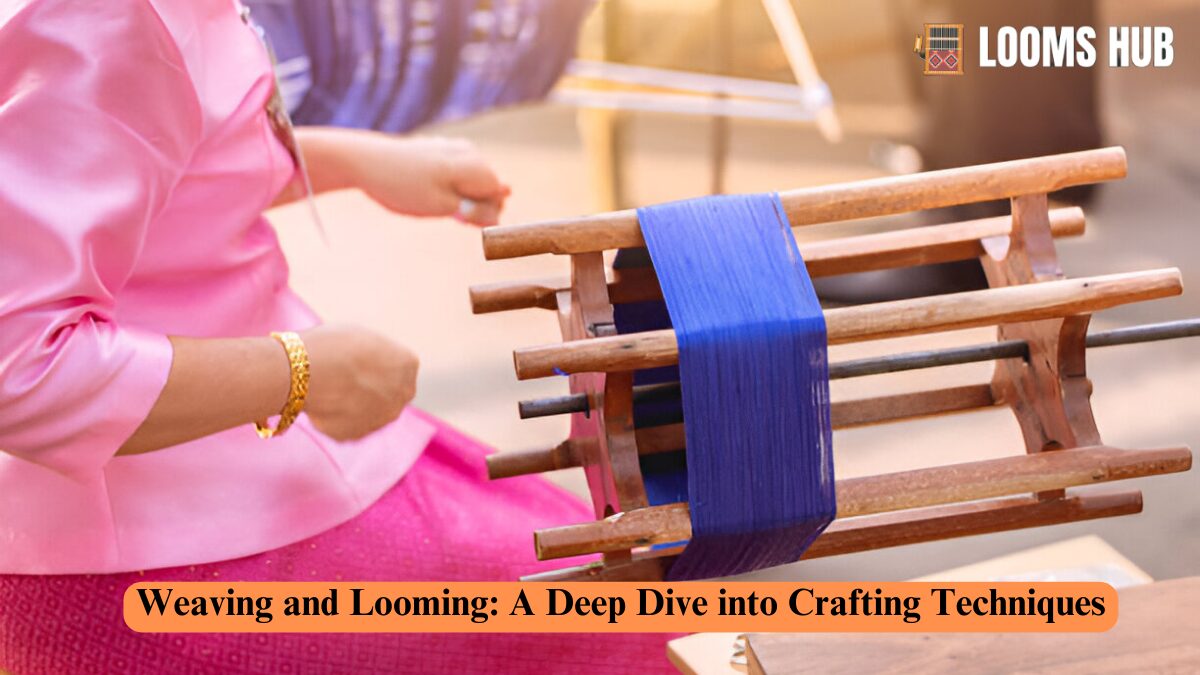Weaving and weaving are ancient practices that have been essential to human culture for thousands of years. From clothing to tapestries, these crafts have shaped the way societies produce textiles. With the rise of sustainable fashion and the renewed interest in handmade goods, weaving and looming are experiencing a comeback, offering creators a chance to combine traditional methods with modern creativity.
Whether you’re a beginner or an experienced artisan, this article will guide you through the art of weaving and looming. We’ll explore the history, tools, techniques, and how you can start your weaving journey. By the end, you’ll have a deeper understanding of these crafts, and you may even feel inspired to try them yourself.
What is Weaving and looming?
Understanding Weaving
Weaving involves interlacing two sets of threads warp (the lengthwise threads) and weft (the crosswise threads) to form a fabric. The warp threads are held in place, while the weft threads are woven through them to create the desired fabric structure.
Understanding Looming
Looming refers to the specific technique of using a loom a device designed to hold the warp threads under tension while you weave the weft threads through them. A loom allows weavers to control the spacing and tension of the threads, leading to more precise and intricate patterns.
Differences between Weaving and Looming:
- Weaving is the broader term for the process of creating fabric.
- Looming is the specific method of using a loom to facilitate weaving.
The Tools of the Trade
Types of Looms
There are different types of looms available, each serving distinct purposes. Let’s look at some of the most common looms and when to use them.
| Loom Type | Description | When to Use |
| Frame Loom | A simple, portable loom is ideal for beginners. It holds warp threads in a rectangular or square frame. | Perfect for small projects like scarves and wall hangings. |
| Floor Loom | A larger loom that stands on the ground. It allows for more complex designs and larger projects. | Best for advanced weavers creating large textiles or intricate designs. |
| Table Loom | Smaller than the floor loom but offers more versatility than a frame loom. | Ideal for weavers who want more complexity but don’t have the space for a large floor loom. |
| Rigid Heddle Loom | Combines the simplicity of a frame loom with the features of a floor loom, making it easy to use. | Great for beginners who want to experiment with different weaving styles. |
Each loom type has its benefits depending on your skill level and the kind of project you’re working on.
Weaving Tools
Besides the loom, there are several essential tools used in weaving:
- Shuttles: Tools used to carry the weft thread across the loom. They come in different sizes, depending on the loom and the type of fabric you’re creating.
- Heddles: These help separate the warp threads, making it easier for the shuttle to pass through.
- Reeds: The reed controls the spacing of the warp threads, ensuring that the fabric maintains its structure.
- Bobbins: Small spools used to hold the weft thread while you’re weaving.
Essential Accessories
- Warping Board: This tool helps you measure and prepare the warp threads before placing them on the loom.
- Combs and Threading Hooks: These tools help organize the threads and keep them aligned as you weave.
Weaving Techniques and Styles
Basic Weaving Techniques
- Plain Weave:
- The simplest weaving pattern, where the weft alternates over and under the warp threads. This technique is used in fabrics like cotton and linen.
- Twill Weave:
- A technique where the weft threads pass over multiple warp threads at a time, creating a distinctive diagonal pattern. It’s commonly used in denim.
- Satin Weave:
- The weft threads pass over several warp threads at once, creating a smooth, glossy finish. Satin and silk fabrics are often made using this technique.
Advanced Weaving Techniques
- Jacquard Weaving:
- This technique allows for intricate patterns and designs to be woven into the fabric, often used for tapestries and decorative fabrics.
- Tapestry Weaving:
- A form of weaving where the weft threads are woven to create pictorial or decorative designs. This method often requires a lot of patience and precision.
- Overshot Weaving:
- This is a technique where the weft threads go over the warp threads and create a raised design pattern.
Looming Techniques
- Warp vs. Weft:
- The warp is the foundation of the fabric, held taut on the loom. The weft is woven through the warp to create the fabric.
- Tension:
- Maintaining consistent tension is crucial for producing high quality woven fabric. Too much tension can distort the fabric, while too little can result in a loose weave.
The Weaving Process: Step-by-Step
Creating woven fabric is a multi step process. Here’s how to get started:
Preparing the Loom
- Set up the Loom:
- Secure the warp threads onto the loom. Make sure they’re evenly spaced and under consistent tension.
- Warping the Loom:
- Measure the required length of the warp thread and thread it through the loom. Use a warping board for precision.
Weaving the Fabric
- Thread the Shuttle:
- Load the shuttle with the weft thread. Start weaving by passing the shuttle over and under the warp threads, alternating directions.
- Beat the Weft:
- Use a reed or comb to push the weft threads tightly together after each pass. This ensures the fabric remains compact and even.
Finishing Touches
- Remove the fabric from the loom.
- Once you’ve finished weaving, carefully cut the fabric off the loom.
- Trimming and Knots:
- Trim any excess threads and tie knots to secure loose ends.
- Washing and Pressing:
- Depending on the material, wash the fabric to remove any excess dirt or oils. Then, press it flat to finish.
The Benefits of Weaving and Looming
Creative Expression
Weaving is an incredibly versatile art form, allowing you to experiment with different textures, colors, and patterns. Whether you’re making practical items like scarves or artistic pieces like tapestries, weaving gives you endless opportunities for creativity.
Therapeutic Effects
Weaving can be a calming, meditative process. It requires focus, which can help clear your mind and reduce stress. The rhythmic nature of weaving provides a form of mindfulness that many find beneficial for their mental health.
Sustainable Fashion
As interest in sustainability grows, weaving and looming provide an eco-friendly way to create custom textiles. By weaving your fabric, you can reduce waste and contribute to the slow fashion movement.
Weaving and Looming in Modern Times
Current Trends in Weaving and Looming
Weaving is no longer just a traditional craft; it’s making waves in modern fashion. Designers are increasingly using handwoven textiles in their collections, bringing a touch of authenticity and individuality to their work. Whether it’s woven accessories or custom-made garments, weaving has become a symbol of sustainability in the fashion industry.
How to Learn Weaving and Looming
Interested in learning how to weave? There are many resources available:
- Online Courses: Websites like Skillshare and Craftsy offer courses for beginners to advanced weavers.
- Local Workshops: Check your community center or craft store for weaving workshops.
- Books: There are plenty of books that cover the basics of weaving, along with advanced techniques.
FAQs
What materials do I need to start weaving?
To get started with weaving, you’ll need the following basic materials:
- A loom (frame loom, rigid heddle loom, or floor loom depending on your needs)
- Warp threads (cotton, wool, or other fibers)
- Weft threads (the material you’ll weave through the warp)
- A shuttle to carry the wet
- A reed for spacing the warp threads
- A warping board to measure your warp threads
- Scissors and needles for finishing touches
Is weaving a difficult skill to learn?
Weaving can be challenging at first, but it’s accessible for beginners. Starting with a simple frame loom and a basic weave like plain weave will help you build your skills gradually. With time and practice, you’ll get more comfortable with advanced techniques.
How long does it take to weave fabric?
The time it takes to weave fabric depends on the project’s complexity, the loom you’re using, and the type of weave. For example, a simple scarf on a frame loom may take a few hours, while a large tapestry on a floor loom can take several weeks or even months.
Can I weave without a loom?
Yes! You can try simple weaving techniques without a loom using a weaving board or by hand. While looms provide more precision and ease, hand weaving can still produce beautiful, unique results, especially for small projects like wall hangings.
What are some common mistakes beginners make in weaving?
- Inconsistent tension: Not keeping the warp threads at an even tension can lead to uneven weaving.
- Skipping warping steps: Properly measuring and setting up your warp threads is crucial to a successful project.
- Overloading the shuttle: Using too much weft thread in the shuttle can make weaving difficult and result in bulky fabric.
Conclusion
Weaving and weaving are timeless arts that combine history, creativity, and skill. Whether you’re interested in creating your fabrics, contributing to the slow fashion movement, or simply trying a new craft, weaving is an accessible and rewarding practice. With the right tools and techniques, you can explore endless creative possibilities.
So grab your loom, choose your favorite yarn, and begin your weaving journey today. The world of fabric awaits you.



